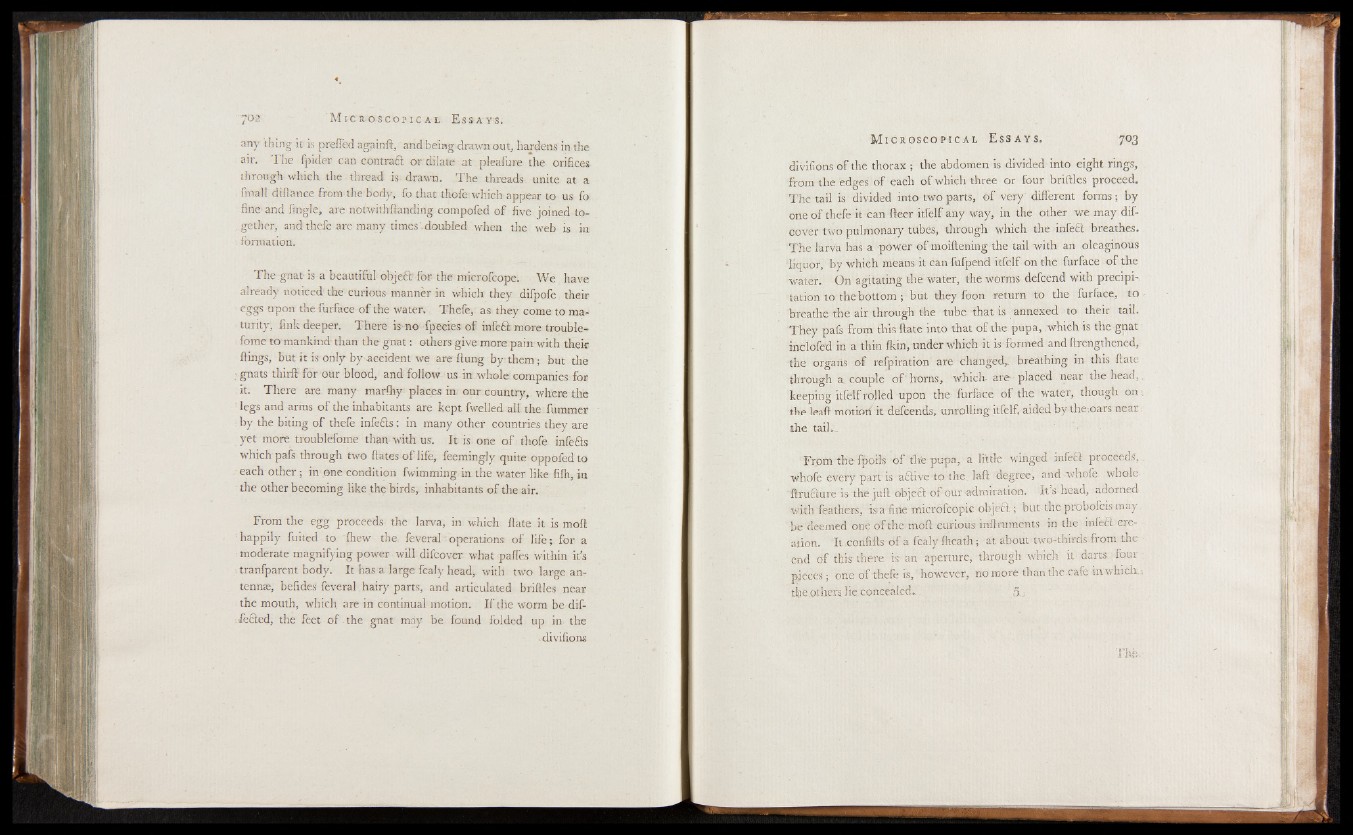
any thing it is prefled againft, and being drawn out, hardens in the
air. The fpider can contract o r dilate at pleafure the orifices
through which the thread is. drawn. The threads unite at a
final! diftance from the body, fo that thofe which appear to us fo
fine and Angle, are notwithftanding compofed of five joined together,
and thefe are many times'doubled when the web is in
. formation.
The gnat is a beautiful objeft for the microfcope. We have
already noticed the curious manner in which they difpofe their
eggs upon the furface of the water. Thefe, as they come to maturity,
fink deeper. There is* no fpecies of infeffc more trouble-
fome to mankind than the gnat: others give more pain with their
flings, but it is only by accident we are flung by them ; but the
■ gnats thirft for our blood, and follow us in whole companies for
it. There are many rnarlhy places in. our country, where the
legs and arms o f the inhabitants are kept fwelled all the fummer
by the biting of thefe infects: in many other countries they are
yet more troublefome than with us. It is one o f thofe infe&s
which pafs through two ftates o f life, feemingly quite oppofed to
each other; in one condition fwimming in the water like fifh, in
the other becoming like the birds, inhabitants o f the air.
From the egg proceeds the larva, in which ftate it is moll
happily fuited to fhew the feveral - operations o f life; for a
moderate magnifying power will difcover what pafles within it’s
tranfparent body. It has a large fcaly head, with two large antennas,
befides feveral hairy parts, and articulated briftles near
the mouth, which are in continual motion. I f the worm be dif-
fecled, the feet of the gnat may be found folded up in the
.divifions
divifions of the thorax ; the abdomen is divided into eight rings,
from the edges of each o f which three or four briftles proceed.
The tail is divided into two parts, o f very different forms; by
one o f thefe it can fleer itfelf any way, in the other we may difcover
two pulmonary tubes, through which the infect breathes.
The larva has a power of moiftening the tail with an oleaginous
liquor, by which means it can fufpend itfelf on the furface of the
water. On agitating the water, the worms defcend with precipitation
to the bottom ; but they foon return to the furface, to .
breathe the air through the tube that is annexed to their tail.
They pafs from this ftate into that o f the. pupa, which is the gnat
inclofed in a thin fkin, under which it is formed and ftrengthened,
the organs of refpiration are changed,, breathing in this ftate
through a couple of'horns, which- are- placed near the head,.
keeping itfelf rolled upon the- furface o f the water, though on;
the leaft motion it defcends, unrolling itfelf, aided by the-.oars near
the tail..
From the fpoil's o f the pupa, a little winged infeft proceeds,.
w.hofe every part is attive to the laft degree, and whofe whole
ftrufture is the juft objeftof our admiration. Its head, adorned
with feathers, iaa fine microfcopic objefl.; but the probofcis may
be deemed one of the moft curious inftruments in the infeft creation.
It .confifts o f a fcaly flieath; at about two-thirds from the -
end of this there is an aperture, through which it darts four
pjeces; one of thefe is, however, no more than the cafe m which.:
the others lie..concealed„. 5..;
T i t s